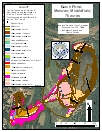Black Pond, Meriden - 2004
2004 Aquatic Plant Survey of Black Pond
76-acre Black Pond, located on the Middlefield-Meriden border, is divided into two areas joined by a narrow channel. A talus slope rises to a trap rock ridge from the eastern shore, and the bottom of the pond drops steeply to a maximum depth of 21 feet. Emergent plants grow on the marshy southern shores of both sections of Black Pond as well as on much of the western shore of the pond’s larger, northeast section. A number of houses have been built on the western and northern shores of the smaller section of the pond.
A total of 19 aquatic plant species were recorded in 2004, including two invasive species – variable-leaf watermilfoil hybrid (Myriophyllum heterophyllum X laxum) and curlyleaf pondweed (Potamogeton crispus) – and 13 other submerged species. The most abundant submerged species in the main part of the pond during the 2004 survey were flat-stemmed pondweed (Potamogeton zosteriformis) and Robbins' pondweed (Potamogeton robbinsii).Flat-Stemmed pondweed was collected in 70% of the 80 samples taken along transects in Black Pond. White water lily (Nymphaea odorata) was most abundant among the floating-leaved species. Submerged vegetation was abundant in shallow water of the pond but generally was absent where the water was more than 12 feet deep. Few plants were found among the rock that formed the bottom on the steep, eastern side of the pond.
In addition to flat-stemmed pondweed, the northern section of Black Pond had individual plants or small patches of the two invasive species, curlyleaf pondweed and variable-leaf watermilfoil hybrid, plus Canadian waterweed (Elodea canadensis) and coontail (Ceratophyllum demersum). Abundant floating-leaved species were watershield (Brasenia schreberi), white water lily, and yellow water lily (Nuphar variegata).
Robbins' pondweed and flat-stemmed pondweed were abundant along the western side of the pond; also present were large-leaf pondweed (Potamogeton amplifolius), coontail, Canadian waterweed, and variable-leaf watermilfoil hybrid. Floating-leaved species became increasingly abundant farther south, where the shallow channel connects the two parts of the pond. Humped bladderwort (Utricularia gibba) was found near the opening to the channel.
Most abundant in the southern part the main section of the pond were flat-stemmed pondweed and Robbins' pondweed. Other species found in that area included large-leaf pondweed, curlyleaf pondweed, variable-leaf watermilfoil hybrid, Canadian waterweed, coontail as well as yellow water lily and other floating-leaved species.
The abundance and diversity of the aquatic plants was sharply lower on the eastern edge of the main part of the pond. Flat-Stemmed pondweed was limited to a narrow band, punctuated by small patches of Robbins' pondweed. In the northeast part of the pond, flat-stemmed pondweed, Robbins' pondweed, coontail, and variable-leaf watermilfoil hybrid were found.
Plants in the shallow water along the channel to the smaller, southwest part of Black Pond included floating-leaved species, especially white water lily, plus flat-stemmed pondweed, floating-leaf pondweed (Potamogeton natans) and variable-leaf watermilfoil hybrid. An estimated 30 percent of the flowers on the white water lily had some pink coloring in their petals, which indicates a horticultural variety. Other plants found in the southwest part of the pond included coontail, Canadian waterweed, large-leaf pondweed, watershield, and yellow water lily.
|
Species recorded in our 2004 survey of Black Pond. |
|||
| Arrowhead |
Floating-Leaf pondweed |
Robbins' pondweed | Watershield |
|
Canadian waterweed |
Humped bladderwort |
Small pondweed |
White water lily |
| Coontail |
Illinois pondweed |
Southern naiad |
Yellow water lily |
| Large-Leaf pondweed |
Variable pondweed | Zigzag bladderwort | |
| Flat-Stemmed pondweed |
Leafy pondweed |
Variable-Leaf watermilfoil hybrid* | |
Other Black Pond Surveys: 2015


